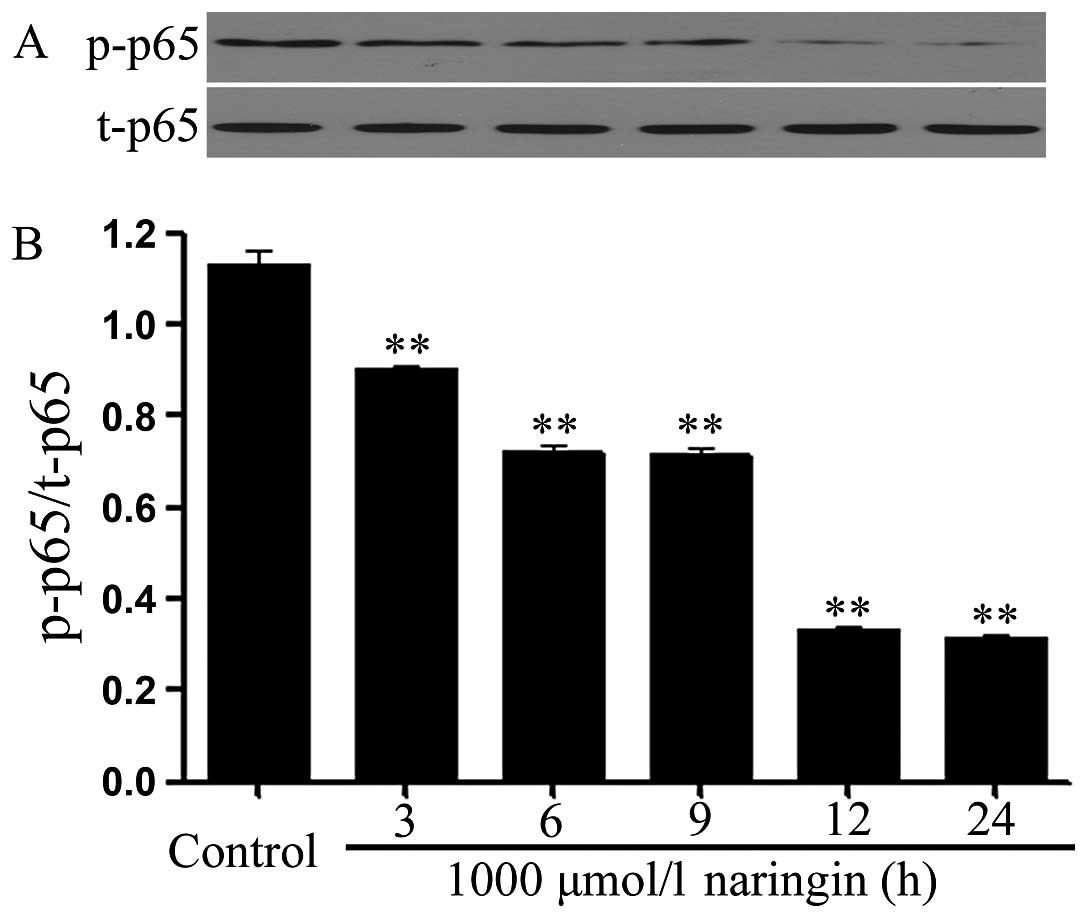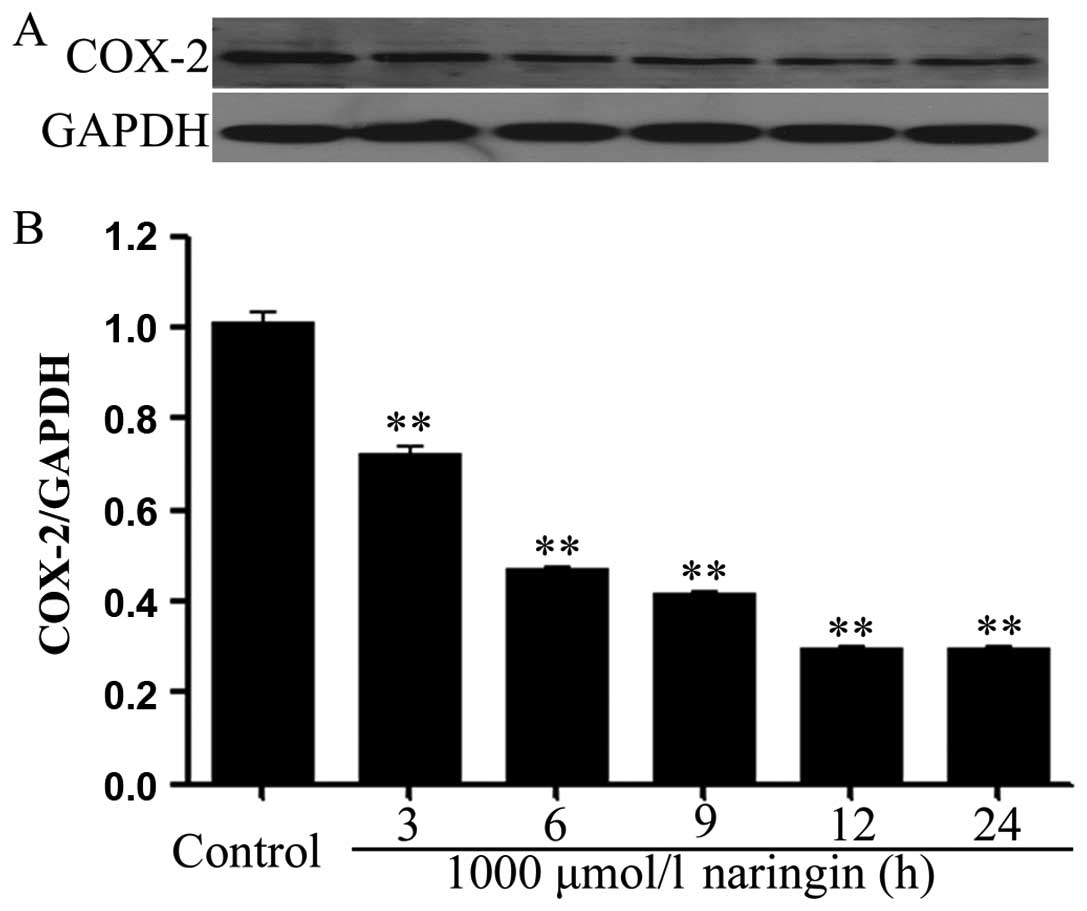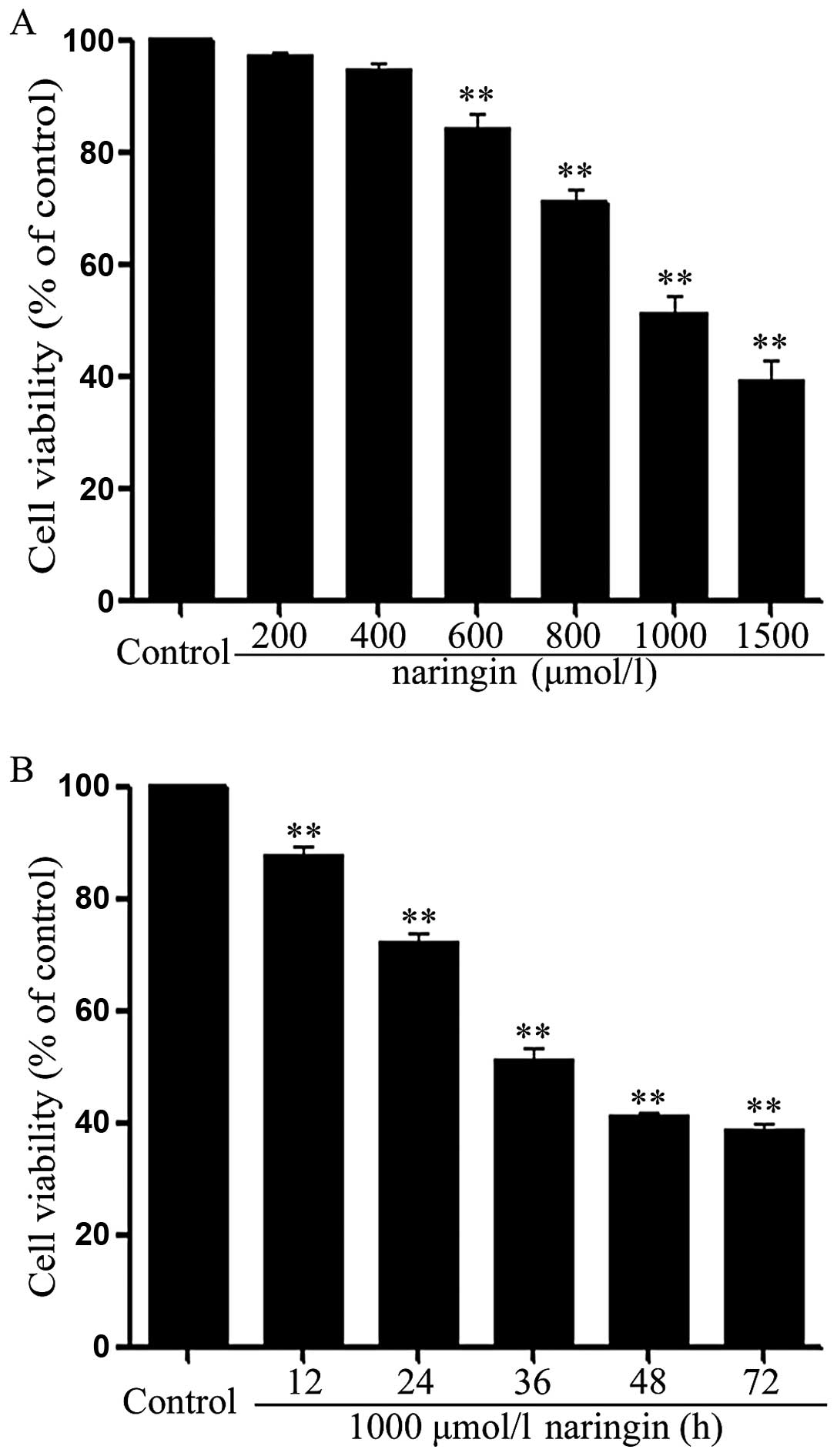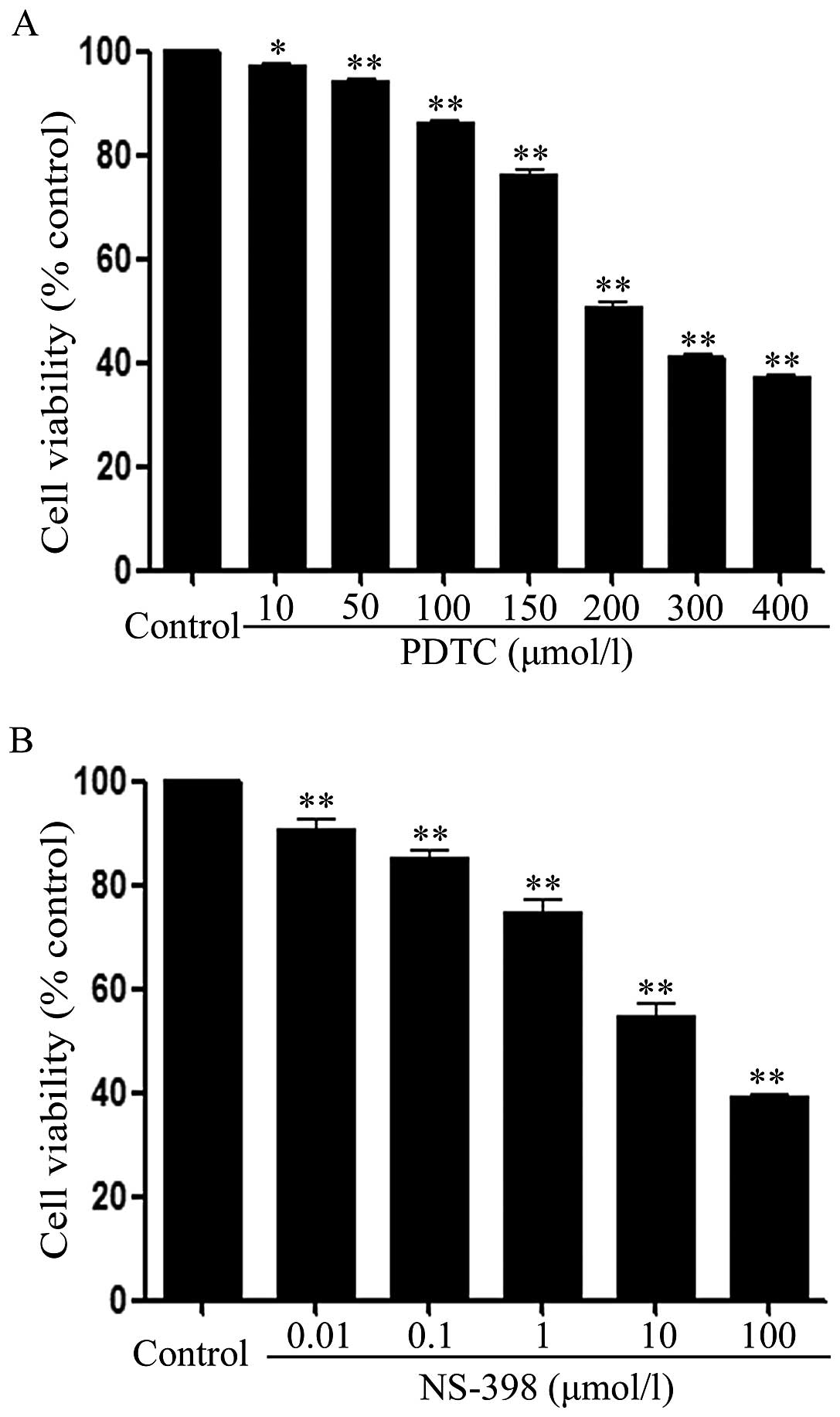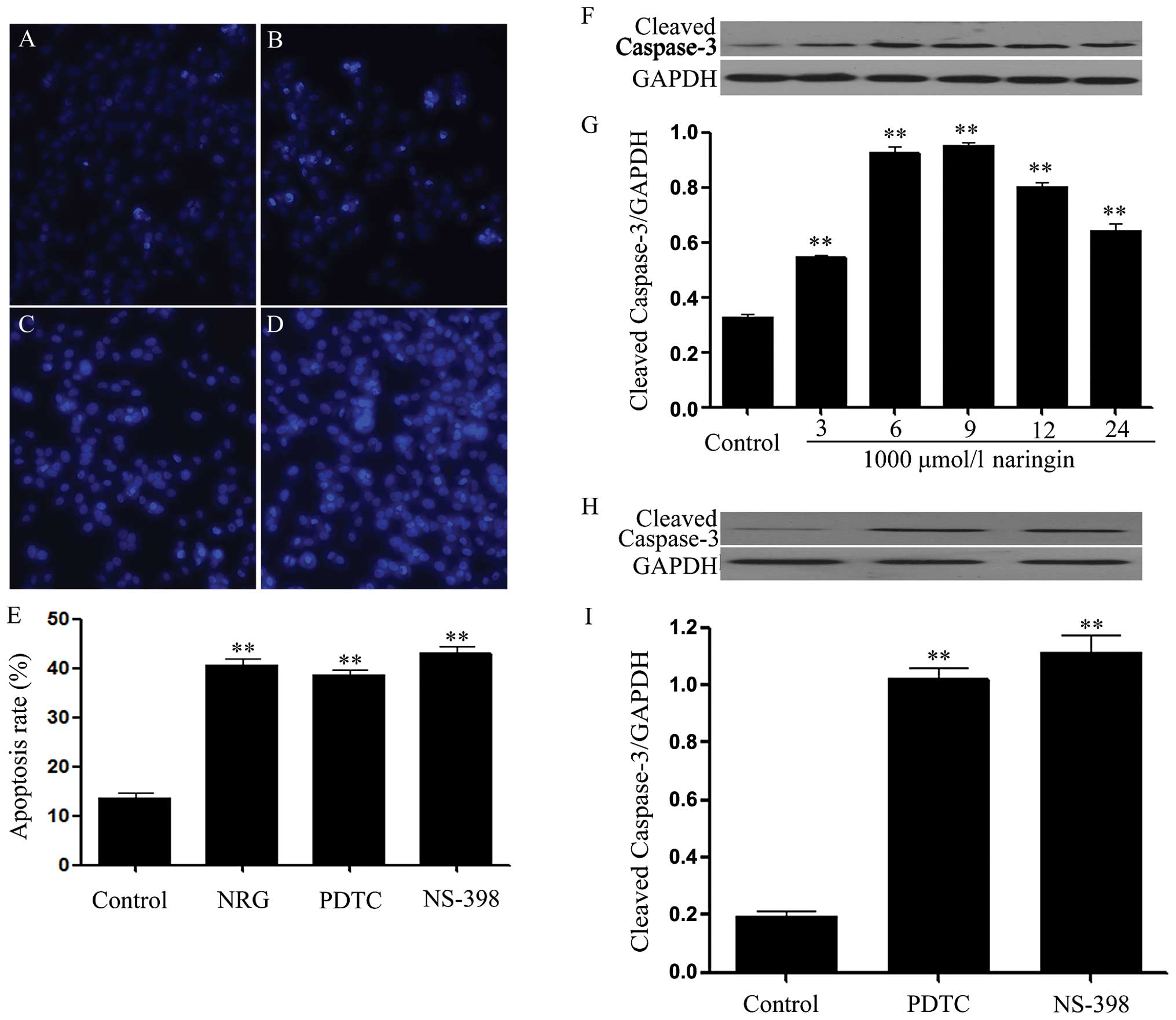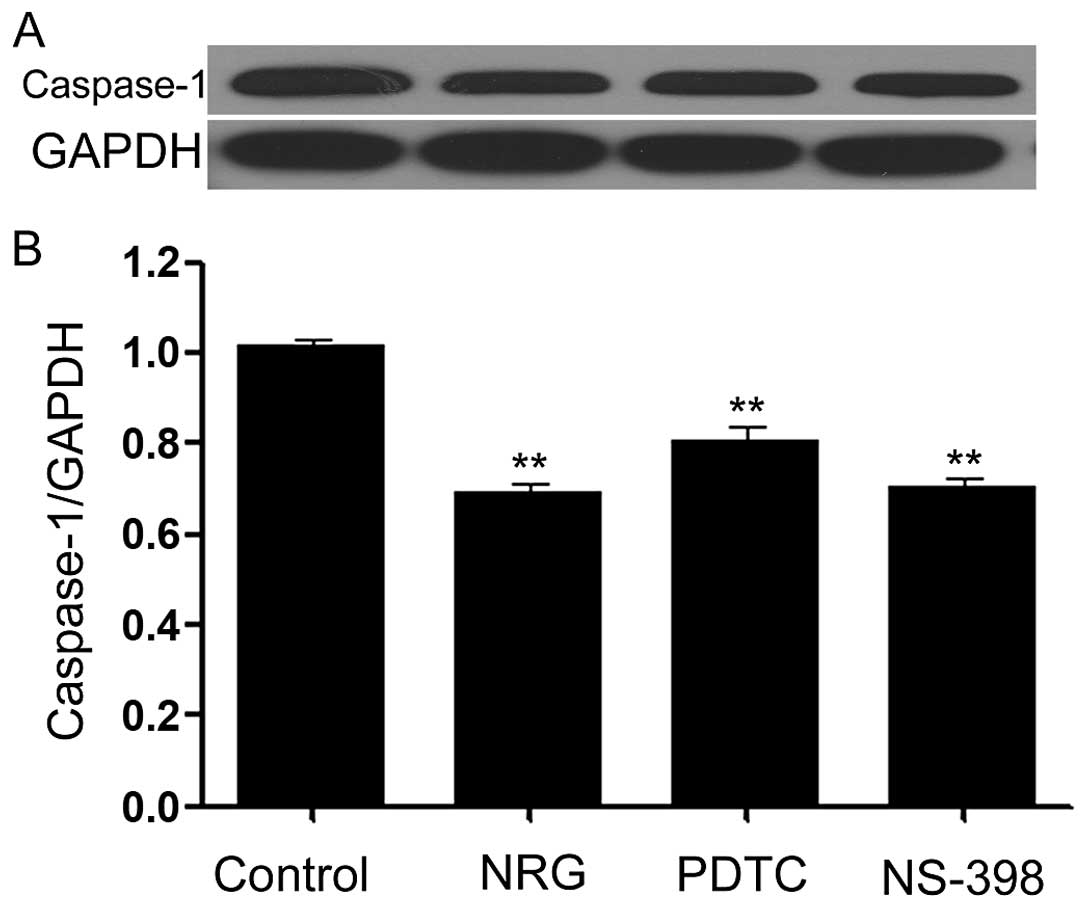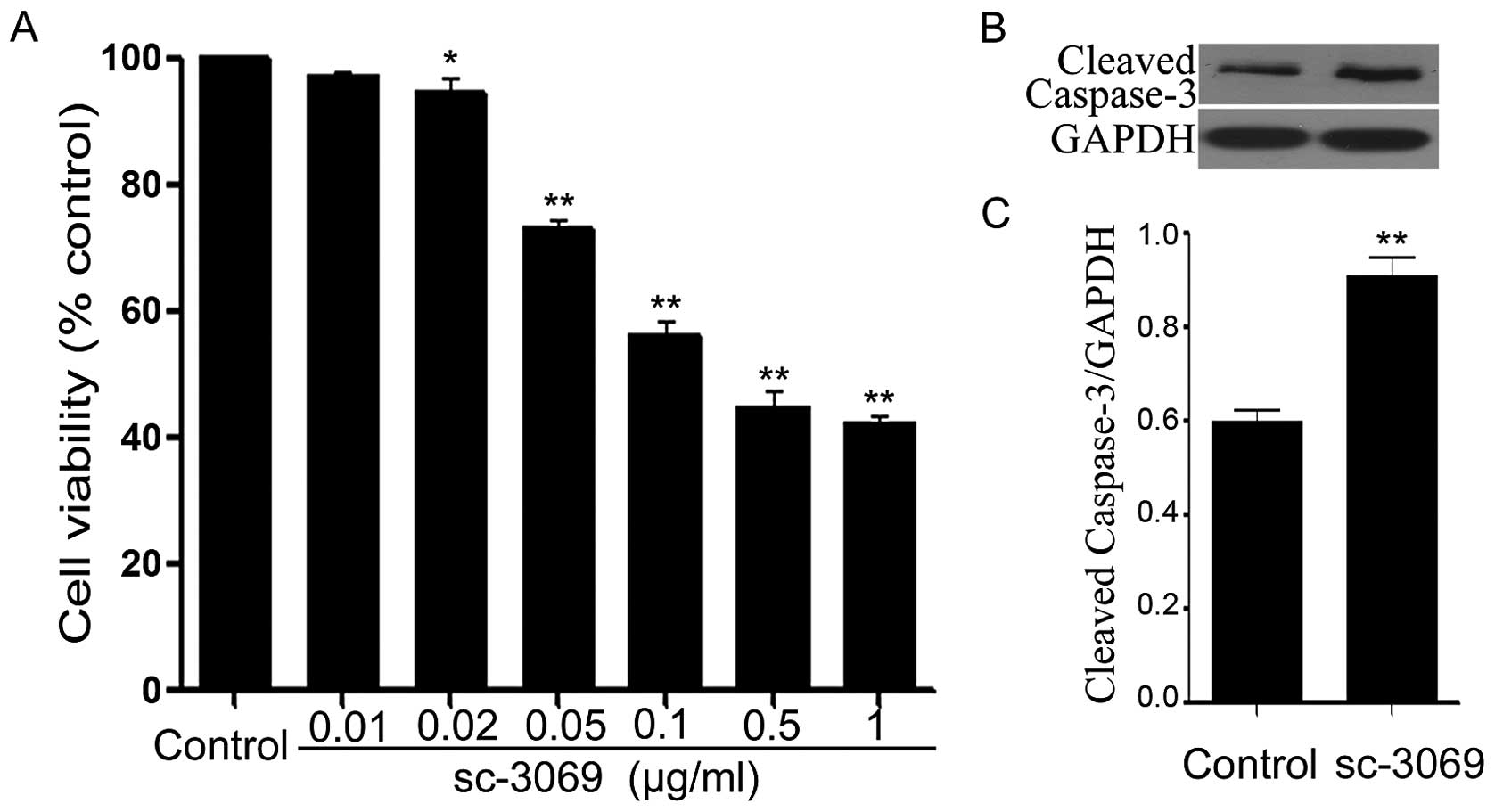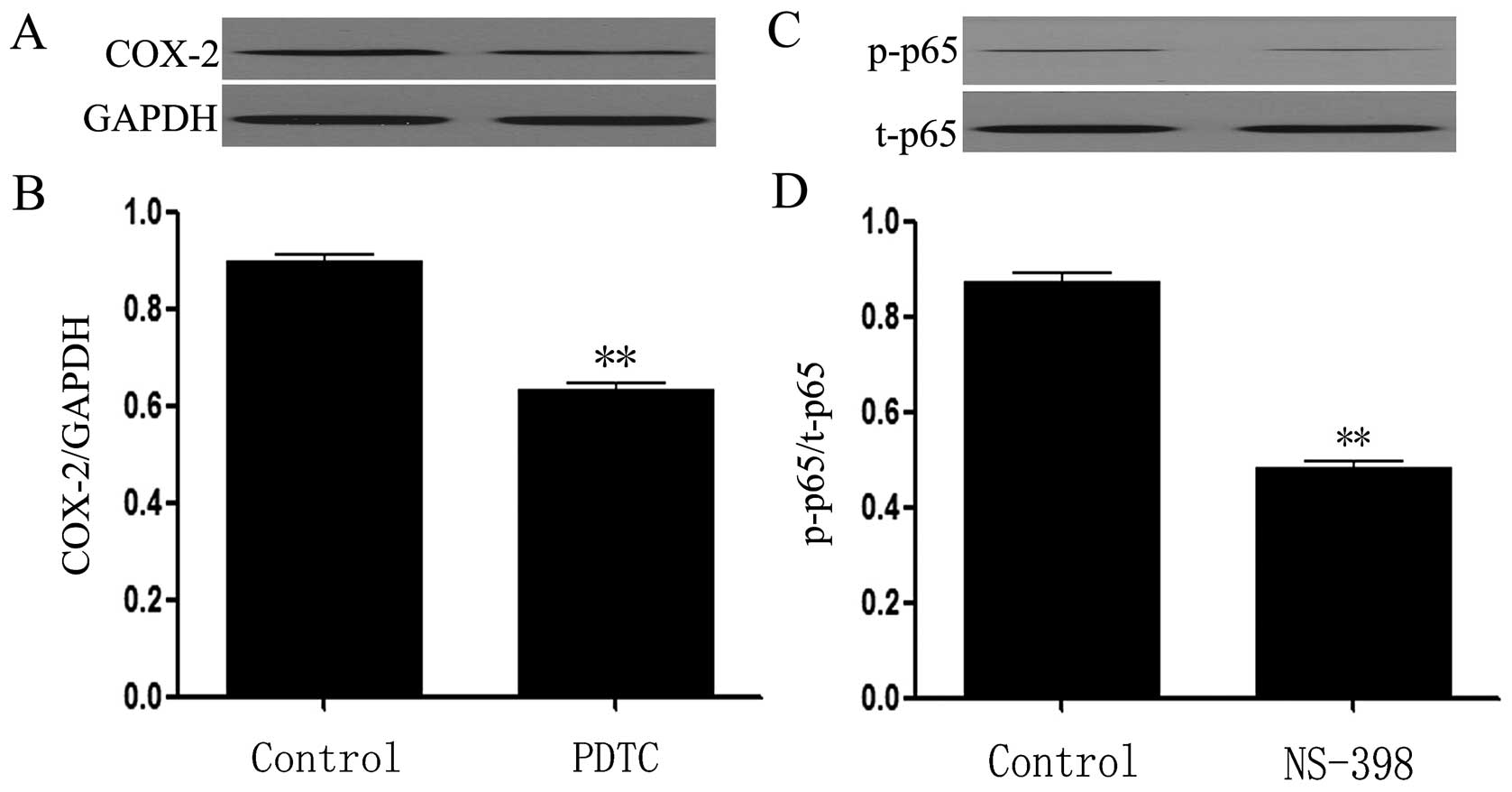Naringin inhibits growth and induces apoptosis by a mechanism dependent on reduced activation of NF‑κB/COX‑2‑caspase-1 pathway in HeLa cervical cancer cells
- Authors:
- Published online on: August 22, 2014 https://doi.org/10.3892/ijo.2014.2617
- Pages: 1929-1936
Abstract
Introduction
Cervical cancer contributes to be an important world health problem for women. It is the third most commonly diagnosed cancer and the fourth cause of cancer death in females world-wide. The role of human papillomavirus (HPV) infection has been extensively investigated and considered as the pathogenesis of both cervical cancer and its precursor damage (1). Of note, increasing evidence indicates that additional non-viral molecular pathways are involved in the initiation and progression of the desease. Thus, to explore the effects of the signaling pathways on cell growth and apoptosis is useful to identify the underlying mechanisms of carcinogenesis and to find the potential therapeutic targets.
Nuclear factor-κB (NF-κB) is a transcription factor that controls numerous genes regulating various cell functions (2). NF-κB family is composed five subunits, including p50 (NF-κB1), p52 (NF-κB2), p65 (RelA), RelB and c-Rel, each of which may form homo- or heterodimers. Among them, nuclear translocation of p65 subunit is a key step in the activation of NF-κB (3). NF-κB signaling pathway plays important roles in general inflammatory response and cell death (4–6). We have recently shown that the inhibition of NF-κB reduces the levels of inflammatory factors, such as IL-6 and IL-8, as well as COX-2 in chemical hypoxia-treated HaCat cells (4,5). Furthermore, it has reported that NF-κB has a critical role in malignancies related to chronic inflammation, due to the activation of genes that promote cell proliferation, angiogenesis and survival (7,8). The activation of NF-κB pathway triggered by HPV 16E5, E6 and E7 oncoproteins is associated with cervical carcinogenesis and progression (9). NF-κB is constitutively activated, which promotes human cervical cancer progression and poor prognosis (10,11). Notably, NF-κB is also involved in overexpression of COX-2 by HPV 16E5 (9).
COX is the rate-limiting enzyme in the arachidonic acid cascade that produces prostaglandins (PG) (12). There are two isoforms of COX. COX-1 is constitutively expressed in almost all tissues and involved in maintaining homeostasis. In contrast, COX-2 is induced immediately in response to inflammatory stimuli including mitogens, growth factors and cytokine (13). Increasing evidence has indicated that COX-2 levels are elevated in several malignancies, such as liver, colon, prostate, gall bladder, lung, skin and gynecologic cancer (14–21). Accumulating studies have demonstrated that overexpressed COX-2 in cervical cancer is related to lymph node metastasis (22) and resistance to radiation therapy and chemotherapy (21,23). In addition, oxyphenbutazone (a non-selective COX inhibitor) treatment markedly improves 5-year survival rates in cervical cancer patients receiving radiation therapy (24). A recent study also reported that celecoxib, a selective COX-2 inhibitor, radiosensitizes the human cervical cancer HeLa cells (25). Although NF-κB has been shown to be a positive regulator of COX-2 expression in response to various cytokines and growth factors in some cell types (26,27), such as in human colorectal cancer cells (27), whether COX-2 was implicated in the regulation of NF-κB expression in cervical cancer cells in unclear.
Another signal molecule involved in the activation of NF-κB is caspase-1. Caspase-1, also known as interleukin 1β (IL-1β) converting enzyme, is an initiator caspase that is originally the active proinflammatory cytokine IL-1β (28). Caspase-1 has been shown to be an activator of NF-κB in B cells (29), whereas caspase-1 knockout macrophages have decreased NF-κB activity (30). Although generally categorized as cytokine-processing caspase, caspase-1 also plays important roles in apoptosis in some cells, such as neurons (31), human ovarian cancer cells (32), prostate cancer cells (33) and pancreatic cancer cells (34). However, it is unknown what is the relationship among caspase-1, NF-κB and COX-2, and what are the roles of caspase-1 in cell growth and apoptosis in cervical cancer cells.
Flavonoids are a large class of natural polyphenolic compounds, existing in a wide variety of fruits and vegetables regularly consumed by humans. Naringin (NRG, the glycoside of the flavonone, naringenin), one of the most abundant flavonoids in grape fruit and other citrus fruits, has been reported to have multiple pharmacological effects, for example, antioxidant (35,36), anti-inflammatory (36,37), antiapoptotic (35,38,39) and antiviral (40) effects. Importantly, recent studies have demonstrated that increased dietary consumption of NRG is related to attenuation of the risk of certain cancers, such as breast cancer and lung cancers (41,42). In addition, the findings from in vivo and in vitro studies indicated that NRG suppresses colon cancer cells (43), urinary blader cancer cells (44), human breast cancer cells (45) and human cervical cancer (SiHa) cells (46). Although many studies have analyzed the effects of NRG on the tumor growth inhibition and apoptosis induction, in several cell lines (41,46), the signaling pathways involved in these effects on cancer cells remain to be investigated.
The present study soughs to explore: i) the roles of NF-κB-COX-2/caspase-1 pathway in regulating cell growth and apoptosis; ii) the roles of inhibition of this pathway in NRG-induced cell growth inhibition and apoptosis in cervical cancer (HeLa) cells. This study demonstrated that NRG induces not only cell growth inhibition, but also apoptosis by inhibiting the NF-κB-COX-2/caspase-1 pathway in cervical cells.
Materials and methods
Materials
Naringin, Hoechst 33258 and NS-398 were purchased from Sigma-Aldrich (St. Louis, MO, USA). The cell counter kit-8 (CCK-8) was supplied by Dojindo Laboratories (Kumamoto, Japan). Fetal bovine serum (FBS) and Dulbecco’s modified Eagle’s medium (DMEM) were obtained from Gibco-BRL (Grand Island, NY, USA). Anti-COX-2 antibody, anti-p-NF-κB p65 antibody, anti-total (t)-NF-κB p65 antibody, anti-caspase-1 antibody and anti-caspase-3 were purchased from Cell Signaling Technology (Boston, MA, USA), HRP-conjugated secondary antibody and BCA protein assay kit were obtained from KangChen Bio-tech, Inc (Shanghai, China). Enhanced chemiluminescence (ECL) solution was purchased from KeyGen Biotech (Nanjing, China).
Culture and treatments
The HeLa cells, a human cervical cancer HeLa cell line, were supplied by Sun Yat-sen University Experimental Animal Center (Guangzhou, China). The cells were cultured in DMEM medium supplemented with 10% FBS at 37°C under an atmosphere of 5% CO2 and 95% air.
To explore the anticancer effects of NRG on growth and apoptosis, HeLa cells were treated with 1,000 μmol/l NRG for the indicated times. To determine the roles of NF-κB, COX-2 and caspase-1 in the growth and apoptosis, HeLa cells were treated with 1,000 μmol/l PDTC (an inhibitor of NF-κB) or 10 μmol/l NS-398 (an inhibitor of COX-2) or 0.1 μg/ml SC-3069 for 24 h.
Cell viability assay
HeLa cells were cultured in 96-well plates at a concentration of 1×104/ml, the CCK-8 assay was employed to assess the cell viability of HeLa cells. After the indicated treatments, 10 μl CCK-8 solution at a 1/10 dilution was added to each well and then the plate was incubated for 1.5 h in the incubator. Absorbance at 450 nm was tested with a microplate reader (Molecular Devices, Sunnyvale, CA, USA). The means of the optical density (OD) of five wells in the indicated groups were used to calculate the percentage of cell viability according to the formula below: cell viability (%) = (OD treatment group/OD control group) ×100%. The experiment was repeated in triplicate.
Hoechst 33258 nuclear staining for assessment of apoptosis
Apoptotic cell death was measured by the Hoechst 33258 staining followed by photofluorography. Firstly, HeLa cells were plated in 35-mm dishes at a density of 1×106 cells/well. After the indicated treatments, HeLa cells were fixed with 4% paraformaldehyde in 0.1 mol/l phosphate-buffered saline (PBS, pH 7.4) for 15 min. And then the slides were washed three times with PBS. After staining by 5 mg/ml Hoechst 33258 for 10 min, HeLa cells were washed three times with PBS. The cells were visualized under a fluorescence microscope (Bx50-FLA; Olympus, Tokyo, Japan). Viable HeLa cells displayed a uniform blue fluorescence throughout the nucleus and normal nuclear size, however, apoptotic HeLa cells showed condensed, distorted or fractured nuclei. The experiment was carried out in triplicates.
Western blot assay for expression of protein
After the indicated treatments, HeLa cells were harvested and lysed with cell lysis solution at 4°C for 30 min. The total proteins were quantified using the BCA protein assay kit. Loading buffer was added to cytosolic extracts, and boiled for about 5 min, then the same amount of supernatant from each sample were fractionated by 10% sodium dodecyl sulphate-polyacrylamide gel electrophoresis (SDS-PAGE), and the total proteins were transferred into polyvinylidene difluoride (PVDF) membranes. The membranes were blocked with 5% fat-free milk for 1 h in fresh blocking buffer [0.1% Tween-20 in Tris-buffered saline (TBS-T)] at room temperature, and incubated with either anti-COX-2 antibody (1:1,000 dilution), anti-p-NF-κB p65 antibody (1:1,000 dilution), anti-total (t)-NF-κB p65 antibody (1:1,000 dilution), anti-caspase-1 antibody (1:1,000 dilution) or anti-caspase-3 antibody (1:1,000 dilution) in freshly prepared TBS-T with 3% free-fat milk overnight with gentle agitation at 4°C. The membranes were washed 3 times with TBST and then incubated with a secondary antibody for 1.5 h at room temperature in TBST with 3% fat-free milk [horseradish peroxidase (HRP)-conjugated goat anti-rabbit secondary antibody, 1:2,500 dilution; Kangchen Biotech, Shanghai, China]. Then membranes were washed three times with TBST for 5 min. The immunoreactive signals were visualized by using enhanced chemiluminescence (ECL) detection. In order to quantify the protein expression, the X-ray film was scanned and analyzed with ImageJ 1.47 i software. The experiment was repeated 3 times.
Statistical analysis
All data are presented as the mean ± SEM. Differences between groups were analyzed by one-way analysis of variance (ANOVA) by using SPSS 13.0 (SPSS, Chicago, IL, USA) software, and followed by LSD post hoc comparison test. A significance of p<0.05 was considered significant.
Results
Naringin attenuates the expression of phosphorylated NF-κB p65 in HeLa cells
In order to observe the effect of NRG on activation of NF-κB pathway, HeLa cells were treated with 1,000 μmol/l NRG for 3, 6, 9, 12 and 24 h, respectively. As shown in Fig. 1, the expression level of phosphorylated (p) NF-κB p65 was markedly reduced after exposure of the cells to NRG for the indicated times. The maximal inhibition of p-NF-κB p65 expression appeared after exposure to NRG for 12 to 24 h. However, exposure of HeLa cells to 1,000 μmol/l NRG did not alter the total (t) expression of NF-κB p65 at the indicated times.
Naringin ameliorates the expression of COX-2 in HeLa cells
Similarily, the expression of COX-2 was significantly depressed after exposure of HeLa cells to 1,000 μmol/l NRG for the indicated times (3, 6, 9, 12 and 24 h), respectively. The maximal inhibition of COX-2 expression by NRG was recorded at 12 to 24 h (Fig. 2).
Naringin inhibits growth in HeLa cells
To explore the effect of NRG on growth of HeLa cells, we observed the effect of NRG at different concentrations (200, 400, 600, 800, 1,000 and 1,500 μmol/l). As shown in Fig. 3A, HeLa cells were exposed to the indicated concentrations of NRG for 24 h. At the range from 400 to 1,500 μmol/l, NRG dose-dependently attenuated the cell viability of HeLa cells. NRG at 1,000 μmol/l reduced the cell viability to 51.1–3.1% (p<0.01), compared with the control group. Based on these data, NRG at 1,000 μmol/l was used to perform a time response experiment on growth of HeLa cells. As presented in Fig. 3B, the cell viability was time-dependently inhibited after exposure of HeLa cells to 1,000 μmol/l RNG for the indicated times (12, 24, 36 and 48 h).
NF-κB inhibitor and COX-2 inhibitor block growth of HeLa cells
To investigate the roles of both NF-κB and COX-2 pathways in the inhibitory effect of NRG on HeLa cell growth, the effects of PDTC (an inhibitor of NF-κB) and NS-398 (an inhibitor of COX-2) on the growth were observed. As shown in Fig. 4A, after HeLa cells were exposed to different concentrations (10, 50, 100, 150, 200, 300 and 400 μmol/l) of PDTC for 36 h, the cell viability was decreased in a dose-dependent manner. Similarly, exposure of the cells to the indicated concentrations (0.01, 0.1, 1, 10 and 100 μmol/l) of NS-398 for 36 h dose-dependently attenuated the cell viability (Fig. 4B).
Naringin, PDTC and NS-398 induce apoptosis in HeLa cells
As shown in Fig. 5B, exposure of HeLa cells to 1,000 μmol/l NRG for 24 h induced typical characteristics of apoptosis, as evidenced by the condensation of chromatin, the shrinkage of nuclei and the formation of apoptotic bodies. Similar to the apoptotic effect of NRG, exposure of the cells to 200 μmol/l PDTC or 10 μmol/l NS-398 for 24 h also enhanced the number of apoptotic HeLa cells (Fig. 5C and E).
On the other hand, the effect of NRG on the expression of cleaved caspase-3 (an apoptotic effector) was observed. As illustrated in Fig. 5F and G, exposure of HeLa cells to 1,000 μmol/l NRG for the indicated times (3, 6, 9, 12 and 24 h) markedly upregulated the expression level of cleaved caspase-3, peaking at 9 h. Similarly, exposure of the cells to 200 μmol/l PDTC or 10 μmol/l NS-398 for 24 h also increased the expression level of cleaved caspase-3, respectively (Fig. 5H and I).
Naringin, PDTC and NS-398 downregulate the expression of caspase-1 in HeLa cells
Caspase-1 is one member of inflammasome family (47,48), which has been reported to contribute to tumor growth. Thus, we explored the influences of NRG, PDTC and NS-398 on caspase-1 expression in HeLa cells. As shown in Fig. 6, expression of caspase-1 was observed in the cells. Of note, exposure of the cells to 1,000 μmol/l NRG for 24 h obviously reduced the expression level of caspase-1. In addition, treatment of the cells with 200 μmol/l PDTC or 10 μmol/l NS-398 for 24 h also attenuated caspase-1 expression.
Caspase-1 inhibitor reduces growth and induces apoptosis in HeLa cells
To investigate the roles of caspase-1 in growth of the cells, we examined the effects of SC-3069 (an inhibitor of caspase-1) on the cell viability and apoptosis. As illustrated in Fig. 7A, exposure of the cells to SC-3069 at different concentrations (0.01, 0.02, 0.05, 0.1, 0.5 and 1 μg/ml) for 24 h dose-dependently decreased cell viability.
Furthermore, as shown in Fig. 7B, treatment of HeLa cells with 0.1 μg/ml sc-3096 for 12 h significantly increased expression level of caspase-3, compared with the control group.
There is a positive interaction between NF-κB and COX-2 pathway in HeLa cells
The data from western blot assay showed that exposure of the cells to 200 μmol/l PDTC for 24 dramatically block the expression of COX-2 (Fig. 8A and B, p<0.01), indicating contribution of NF-κB to the activation of COX-2 pathway. Interestingly, treatment of the cells with 10 μmol/l NS-398 for 24 h considerably antagonized the expression of p-NF-κB p65 (Fig. 8C and D, p<0.01), revealing involvement of COX-2 in the activity of NF-κB pathway.
Discussion
The activation of NF-κB (9,10,12) or COX-2 pathway (21–25,49) has been correlated with cervical carcinogenesis and progression. Furthermore, NF-κB is implicated in overexpression of COX-2 by HPV 16E5 (9). However, the relationship between NF-κB and COX-2 in cell proliferation and apoptosis of cervical cancer cells is incomplely understood. In the present study, we provided novel evidence that there is a positive interaction between NF-κB and COX-2 pathway, which may be an important mechanism responsible for cell growth and antiapoptosis in cervical cancer cells. This mechanism is supported by the following results: i) treatment with PDTC, an inhibitor of NF-κB, attenuated the expression level of COX-2; ii) NS-398, an inhibitor of COX-2, reduced the expression of NF-κB p65 subunit; iii) exposure of HeLa cells to PDTC or NS-398 induced growth inhibition and apoptosis, as demonstrated by the decreased cell viability and increased amount of apoptotic cells and cleaved caspase-3 expression.
Apoptosis is the physiologically relevant model of programmed cell death that counterbalances cell proliferation. Activation of the caspase cascade is involved in the execution of apoptosis in a variety of cellular systems. Caspase-1, a member of the so-called ‘inflammatory caspases’ group, is an initiator caspase. Recently, the role of caspase-1 in apoptosis of cancer cells has been receiving attention, but previous studies concering the role of caspase-1 are controversial. Jarry et al (50) have demonstrated obvious downregulation of caspase-1 expression in human colon cancer. Overexpression of caspase-1 enhances the rate of apoptosis in vitro and in vivo in renal cancer cell lines (51). In constrast, Schlosser et al (34) reported that caspase-1 has antiapoptotic function in pancreatic carcinoma. Thus, to explore the functional roles of caspase-1 in cell growth and apoptosis will enhance the understanding of the molecular basis of cervical carcinogenesis and progression. The findings of this study showed that both NF-κB inhibitor (PDTC) and COX-2 inhibitor (NS-398) significantly reduced the expression level of caspase-1, indicating the contribution of NF-κB-COX-2 pathway to activation of caspase-1 in HeLa cells. In addition, SC-3069, an inhibitor of caspase-1, suppressed cell viability and upregulated the expression of cleaved caspase-3 (an executioner of apoptosis), suggesting involvement of caspase-1 in cell growth and antiapoptotic effect in cervical cancer cells. Our results are comparable with those of a previous study that caspase-1 has antiapoptotic effect in pancreatic cancer cells (34). However, our data contrast with previous observations that caspase-1 contributes to apoptotic induction in human ovarian cancer cells (32), prostate cancer cells (33), human colon cancer cells (50) and renal cancer cell lines (51). The apparent discrepancy may reflect specific differences in the molecular mechanisms responsible for the development of various human malignancies. Alternatively, a potential antiapoptotic function for this caspase may be a result of alternative splicing of caspase-1, since caspase-1 has four known isoforms, at least two of which may have antagonistic effect against apoptosis (52).
Another novel finding of the present study is that NRG, a citrus flavonone, exerts its anticancer effects by inhibiting the NF-κB-COX-2/caspase-1 pathway in cervical cancer cells. Citrus fruits contain various flavonoids, and among these natural compounds, NRG has been pharmacologically considered as a potential anticancer agent, due to its anticancer effect on various cancer cells, such as colon cancer cells (43,53), urinary blader cancer cells (44), human breast cancer cells (45) and human cervical cancer (SiHa) cells (46). However, the molecular mechanisms responsible for the anticancer effect of NRG have yet to be complely understood. To the best of our knowledge, no previous studies have focused on NRG-induced cell growth inhibition and apoptosis through the inhibition of NF-κB-COX-2/caspase-1 pathway in human cervical cancer (HeLa) cells.
To investigate this topic, firstly, we observed the roles of NRG in cell growth inhibition and apoptosis in HeLa cells. In agreement with the results of previous studies (43–46), our data showed that NRG had marked anticancer effects, as evidenced by a decrease in cell viability and increases in number of apoptotic cells as well as the expression level of cleaved caspase-3 in HeLa cells. In human cervical cancer (SiHa) cells, administration of NRG also has anti-proliferative effect and increases the expression of caspase-3 and -9 (46), which support our results. Based on the above, it is suggested that NRG may be a potential inducer of cleaved caspase-3 (an executioner of apoptosis) in human cervical cancer (including SiHa and HeLa) cells.
As described above, the present study demonstrated the involvement of NF-κB-COX-2/caspase-1 pathway in cell growth and anti-apoptosis, thus, we further explored the effects of NRG on the activation of NF-κB-COX-2/caspase-1 pathway. The findings of the current study showed that treatment of HeLa cells with NRG markedly attenuated the expression levels of NF-κB p65 subunit, COX-2 and caspase-1. These results revealed that NRG induces growth inhibition and apoptosis, at least in part, through the inhibition of NF-κB-COX-2/caspase-1 pathway in HeLa cells.
In summary, the present study provides novel evidence that the activation of NF-κB-COX-2/caspase-1 pathway contributes to cervical carcinogenesis, including cell proliferation and antiapoptosis. The understanding of the roles of such a signaling pathway is important, as it may lead to the development of novel treatment strategies designed to inhibit this signal cascade for cervical cancer cells. Additionally, the present study provides important new insight into the molecular mechanisms underlying the anticancer effect of NRG in cervical cancer cells. First, NRG reduces cell viability and induces apoptosis. Second, the NRG-induced growth inhibition and apoptosis appears to be linked to the inhibition of activation of NF-κB-COX-2/caspase-1 pathway. The findings of the present study may, in part, explain the therapeutic effects of NRG in treatment of human cervical cancer cells.
Acknowledgements
This study was supported by Special Competitive Allocation Project of Science and Technology Special Financial Funding of Zhanjiang (no. 2013A304) and Science Research Funding of the Guangdong Provincial Population and Family Planning Commission (no. 20110264).
References
|
Münger K, Baldwin A, Edwards KM, et al: Mechanisms of human papillomavirus-induced oncogenesis. J Virol. 78:11451–11460. 2004. | |
|
Karin M and Greten FR: NF-kappaB: linking inflammation and immunity to cancer development and progression. Nat Rev Immunol. 5:749–759. 2005. View Article : Google Scholar : PubMed/NCBI | |
|
Baldwin AS Jr: The NF-kappa B and I kappa B proteins: new discoveries and insights. Annu Rev Immunol. 14:649–683. 1996. View Article : Google Scholar : PubMed/NCBI | |
|
Yang C, Ling H, Zhang M, et al: Oxidative stress mediates chemical hypoxia-induced injury and inflammation by activating NF-κb-COX-2 pathway in HaCaT cells. Mol Cells. 31:531–538. 2011.PubMed/NCBI | |
|
Yang C, Yang Z, Zhang M, et al: Hydrogen sulfide protects against chemical hypoxia-induced cytotoxicity and inflammation in HaCaT cells through inhibition of ROS/NF-κB/COX-2 pathway. PLoS One. 6:e219712011.PubMed/NCBI | |
|
Guo RM, Xu WM, Lin JC, et al: Activation of the p38 MAPK/NF-κB pathway contributes to doxorubicin-induced inflammation and cytotoxicity in H9c2 cardiac cells. Mol Med Rep. 8:603–608. 2013. | |
|
Lu H, Ouyang W and Huang C: Inflammation, a key event in cancer development. Mol Cancer Res. 4:221–233. 2006. View Article : Google Scholar : PubMed/NCBI | |
|
Pollard JW: Tumour-educated macrophages promote tumour progression and metastasis. Nat Rev Cancer. 4:71–78. 2004. View Article : Google Scholar : PubMed/NCBI | |
|
Kim SH, Oh JM, No JH, Bang YJ, Juhnn YS and Song YS: Involvement of NF-kappaB and AP-1 in COX-2 upregulation by human papillomavirus 16 E5 oncoprotein. Carcinogenesis. 30:753–757. 2009. View Article : Google Scholar : PubMed/NCBI | |
|
Li J, Jia H, Xie L, et al: Association of constitutive nuclear factor-kappaB activation with aggressive aspects and poor prognosis in cervical cancer. Int J Gynecol Cancer. 19:1421–1426. 2009. View Article : Google Scholar : PubMed/NCBI | |
|
Wu Z, Peng X, Li J, Zhang Y and Hu L: Constitutive activation of nuclear factor κB contributes to cystic fibrosis transmembrane conductance regulator expression and promotes human cervical cancer progression and poor prognosis. Int J Gynecol Cancer. 23:906–915. 2013. | |
|
Agarwal B, Rao CV, Bhendwal S, Ramey WR, Shirin H, Reddy BS and Holt PR: Lovastatin augments sulindac-induced apoptosis in colon cancer cells and potentiates chemopreventive effects of sulindac. Gastroenterology. 117:838–847. 1999. View Article : Google Scholar : PubMed/NCBI | |
|
Vane JR, Bakhle YS and Botting RM: Cyclooxygenases 1 and 2. Annu Rev Pharmacol Toxicol. 38:97–120. 1998. View Article : Google Scholar | |
|
Bae SH, Jung ES, Park YM, Kim BS, Kim BK, Kim DG and Ryu WS: Expression of cyclooxygenase-2 (COX-2) in hepato-cellular carcinoma and growth inhibition of hepatoma cell lines by a COX-2 inhibitor, NS-398. Clin Cancer Res. 7:1410–1418. 2001.PubMed/NCBI | |
|
Dubois RN: Review article: cyclooxygenase - a target for colon cancer prevention. Aliment Pharmacol Ther. 14(Suppl 1): 64–67. 2000. View Article : Google Scholar : PubMed/NCBI | |
|
Hsu AL, Ching TT, Wang DS, Song X, Rangnekar VM and Chen CS: The cyclooxygenase-2 inhibitor celecoxib induces apoptosis by blocking Akt activation in human prostate cancer cells independently of Bcl-2. J Biol Chem. 275:11397–11403. 2000. View Article : Google Scholar : PubMed/NCBI | |
|
Grossman EM, Longo WE, Panesar N, Mazuski JE and Kaminski DL: The role of cyclooxygenase enzymes in the growth of human gall bladder cancer cells. Carcinogenesis. 21:1403–1409. 2000. View Article : Google Scholar : PubMed/NCBI | |
|
Khuri FR, Wu H, Lee JJ, et al: Cyclooxygenase-2 overexpression is a marker of poor prognosis in stage I non-small cell lung cancer. Clin Cancer Res. 7:861–867. 2001.PubMed/NCBI | |
|
Higashi Y, Kanekura T and Kanzaki T: Enhanced expression of cyclooxygenase (COX)-2 in human skin epidermal cancer cells: evidence for growth suppression by inhibiting COX-2 expression. Int J Cancer. 86:667–671. 2000. View Article : Google Scholar : PubMed/NCBI | |
|
Kulkarni S, Rader JS, Zhang F, et al: Cyclooxygenase-2 is overexpressed in human cervical cancer. Clin Cancer Res. 7:429–434. 2001.PubMed/NCBI | |
|
Ferrandina G, Lauriola L, Distefano MG, et al: Increased cyclooxygenase-2 expression is associated with chemotherapy resistance and poor survival in cervical cancer patients. J Clin Oncol. 20:973–981. 2002. View Article : Google Scholar : PubMed/NCBI | |
|
Ryu HS, Chang KH, Yang HW, Kim MS, Kwon HC and Oh KS: High cyclooxygenase-2 expression in stage IB cervical cancer with lymph node metastasis or parametrial invasion. Gynecol Oncol. 76:320–325. 2000. View Article : Google Scholar : PubMed/NCBI | |
|
Gaffney DK, Holden J, Davis M, Zempolich K, Murphy KJ and Dodson M: Elevated cyclooxygenase-2 expression correlates with diminished survival in carcinoma of the cervix treated with radiotherapy. Int J Radiat Oncol Biol Phys. 49:1213–1217. 2001. View Article : Google Scholar : PubMed/NCBI | |
|
Weppelmann B and Mönkemeier D: The influence of prostaglandin antagonists on radiation therapy of carcinoma of the cervix. Gynecol Oncol. 17:196–199. 1984. View Article : Google Scholar : PubMed/NCBI | |
|
Wang AH, Tian XY, Yu JJ, Mi JQ, Liu H and Wang RF: Celecoxib radiosensitizes the human cervical cancer HeLa cell line via a mechanism dependent on reduced cyclo-oxygenase-2 and vascular endothelial growth factor C expression. J Int Med Res. 40:56–66. 2012. View Article : Google Scholar | |
|
Kang YJ, Wingerd BA, Arakawa T and Smith WL: Cyclooxygenase-2 gene transcription in a macrophage model of inflammation. J Immunol. 177:8111–8122. 2006. View Article : Google Scholar : PubMed/NCBI | |
|
Liu W, Reinmuth N, Stoeltzing O, et al: Cyclooxygenase-2 is up-regulated by interleukin-1 beta in human colorectal cancer cells via multiple signaling pathways. Cancer Res. 63:3632–3636. 2003.PubMed/NCBI | |
|
Thornberry NA, Bull HG, Calaycay JR, et al: A novel heterodimeric cysteine protease is required for interleukin-1 beta processing in monocytes. Nature. 356:768–774. 1992. View Article : Google Scholar : PubMed/NCBI | |
|
Lamkanfi M, Kalai M, Saelens X, Declercq W and Vandenabeele P: Caspase-1 activates nuclear factor of the kappa-enhancer in B cells independently of its enzymatic activity. J Biol Chem. 279:24785–24793. 2004. View Article : Google Scholar : PubMed/NCBI | |
|
Sarkar A, Duncan M, Hart J, Hertlein E, Guttridge DC and Wewers MD: ASC directs NF-kappaB activation by regulating receptor interacting protein-2 (RIP2) caspase-1 interactions. J Immunol. 176:4979–4986. 2006. View Article : Google Scholar : PubMed/NCBI | |
|
Zhang WH, Wang X, Narayanan M, Zhang Y, Huo C, Reed JC and Friedlander RM: Fundamental role of the Rip2/caspase-1 pathway in hypoxia and ischemia-induced neuronal cell death. Proc Natl Acad Sci USA. 100:16012–16017. 2003. View Article : Google Scholar : PubMed/NCBI | |
|
Feng Q, Li P, Salamanca C, Huntsman D, Leung PC and Auersperg N: Caspase-1alpha is down-regulated in human ovarian cancer cells and the overexpression of caspase-1alpha induces apoptosis. Cancer Res. 65:8591–8596. 2005. View Article : Google Scholar : PubMed/NCBI | |
|
Winter RN, Rhee JG and Kyprianou N: Caspase-1 enhances the apoptotic response of prostate cancer cells to ionizing radiation. Anticancer Res. 24:1377–1386. 2004.PubMed/NCBI | |
|
Schlosser S, Gansauge F, Ramadani M, Beger HG and Gansauge S: Inhibition of caspase-1 induces cell death in pancreatic carcinoma cells and potentially modulates expression levels of bcl-2 family proteins. FEBS Lett. 491:104–108. 2001. View Article : Google Scholar : PubMed/NCBI | |
|
Chen J, Guo R, Yan H, et al: Naringin inhibits ROS-activated MAPK pathway in high glucose-induced injuries in H9c2 cardiac cells. Basic Clin Pharmacol Toxicol. 114:293–304. 2014. View Article : Google Scholar : PubMed/NCBI | |
|
Mahmoud AM, Ashour MB, Abdel-Moneim A and Ahmed OM: Hesperidin and naringin attenuate hyper-glycemia-mediated oxidative stress and proinflammatory cytokine production in high fat fed/streptozotocin-induced type 2 diabetic rats. J Diabetes Complications. 26:483–490. 2012. View Article : Google Scholar | |
|
Nie YC, Wu H, Li PB, et al: Anti-inflammatory effects of naringin in chronic pulmonary neutrophilic inflammation in cigarette smoke-exposed rats. J Med Food. 15:894–900. 2012. View Article : Google Scholar : PubMed/NCBI | |
|
Huang H and Wu K, You Q, Huang R, Li S and Wu K: Naringin inhibits high glucose-induced cardiomyocyte apoptosis by attenuating mitochondrial dysfunction and modulating the activation of the p38 signaling pathway. Int J Mol Med. 32:396–402. 2013. | |
|
Chen J, Mo H, Guo R, You Q, Huang R and Wu K: Inhibition of the leptin-induced activation of the p38 MAPK pathway contributes to the protective effects of naringin against high glucose-induced injury in H9c2 cardiac cells. Int J Mol Med. 33:605–612. 2014.PubMed/NCBI | |
|
Kaul TN, Middleton E Jr and Ogra PL: Antiviral effect of flavonoids on human viruses. J Med Virol. 15:71–79. 1985. View Article : Google Scholar : PubMed/NCBI | |
|
So FV, Guthrie N, Chambers AF, Moussa M and Carroll KK: Inhibition of human breast cancer cell proliferation and delay of mammary tumorigenesis by flavonoids and citrus juices. Nutr Cancer. 26:167–181. 1996. View Article : Google Scholar : PubMed/NCBI | |
|
Le Marchand L, Murphy SP, Hankin JH, Wilkens LR and Kolonel LN: Intake of flavonoids and lung cancer. J Natl Cancer Inst. 92:154–160. 2000.PubMed/NCBI | |
|
Vanamala J, Leonardi T, Patil BS, et al: Suppression of colon carcinogenesis by bioactive compounds in grapefruit. Carcinogenesis. 27:1257–1265. 2006. View Article : Google Scholar : PubMed/NCBI | |
|
Kim DI, Lee SJ, Lee SB, Park K, Kim WJ and Moon SK: Requirement for Ras/Raf/ERK pathway in naringin-induced G1-cell-cycle arrest via p21WAF1 expression. Carcinogenesis. 29:1701–1709. 2008. View Article : Google Scholar : PubMed/NCBI | |
|
Schindler R and Mentlein R: Flavonoids and vitamin E reduce the release of the angiogenic peptide vascular endothelial growth factor from human tumor cells. J Nutr. 136:1477–1482. 2006.PubMed/NCBI | |
|
Ramesh E and Alshatwi AA: Naringin induces death receptor and mitochondria-mediated apoptosis in human cervical cancer (SiHa) cells. Food Chem Toxicol. 51:97–105. 2013. View Article : Google Scholar : PubMed/NCBI | |
|
Choi JS and Ryter SW: Inflammasomes: Molecular Regulation and Implications for Metabolic and Cognitive Diseases. Mol Cells. May 19–2014.(Epub ahead of print). | |
|
Man SM, Tourlomousis P, Hopkins L, Monie TP, Fitzgerald KA and Bryant CE: Salmonella infection induces recruitment of Caspase-8 to the inflammasome to modulate IL-1β production. J Immunol. 191:5239–5246. 2013. View Article : Google Scholar | |
|
Yusup G, Akutsu Y, Mutallip M, et al: A COX-2 inhibitor enhances the antitumor effects of chemotherapy and radiotherapy for esophageal squamous cell carcinoma. Int J Oncol. 44:1146–1152. 2014.PubMed/NCBI | |
|
Jarry A, Vallette G, Cassagnau E, et al: Interleukin 1 and interleukin 1beta converting enzyme (caspase 1) expression in the human colonic epithelial barrier. Caspase 1 downregulation in colon cancer. Gut. 45:246–251. 1999. View Article : Google Scholar : PubMed/NCBI | |
|
Ueki T, Takeuchi T, Nishimatsu H, et al: Silencing of the caspase-1 gene occurs in murine and human renal cancer cells and causes solid tumor growth in vivo. Int J Cancer. 91:673–679. 2001. View Article : Google Scholar | |
|
Alnemri ES, Fernandes-Alnemri T and Litwack G: Cloning and expression of four novel isoforms of human interleukin-1 beta converting enzyme with different apoptotic activities. J Biol Chem. 270:4312–4317. 1995. View Article : Google Scholar : PubMed/NCBI | |
|
Chen YC, Shen SC, Chow JM, Ko CH and Tseng SW: Flavone inhibition of tumor growth via apoptosis in vitro and in vivo. Int J Oncol. 25:661–670. 2004.PubMed/NCBI |



